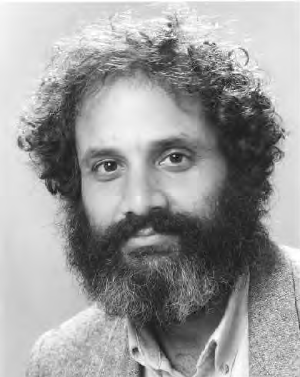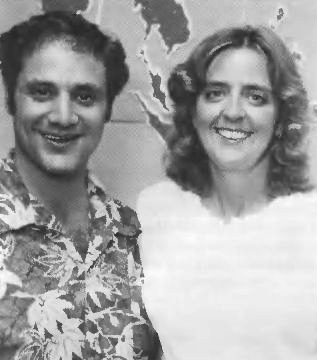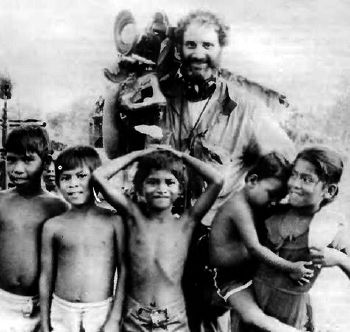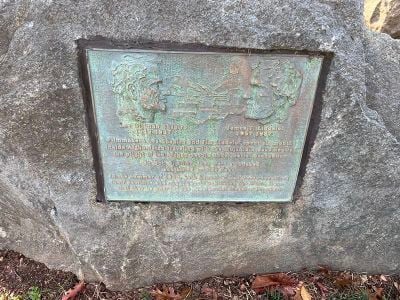Lee Shapiro
Lee Shapiro (1949–1987) was an American documentary filmmaker. His one feature-length film, Nicaragua Was Our Home, was released in 1986. It was filmed in Nicaragua among the Miskito Indians who were then fighting against Nicaraguan government forces. In 1987, Shapiro and fellow filmmaker Jim Lindelof were killed while filming in Afghanistan during the Soviet–Afghan War. Shapiro received the Presidential Medal of Freedom in recognition of his efforts.
Life
Lee Dittman Shapiro was born on May 12, 1949 in Oklahoma.
He began his education planning to become a psychiatrist. While attending medical school at the University of Oklahoma he became interested in film and transferred to the London Film School. On his return to the United States, in 1974 he joined the Unification Church, and attended the Unification Theological Seminary (UTS) from 1976-1978.
While a student at UTS he was known for performing comedy skits together with another student, Michael Jenkins, to the great delight of students and staff. Jenkins said of him:
Our friendship is one of the most rewarding and endearing relationships of my life. Lee is a very jovial and stable person. He has that rare gift of being able to find a joyful outlook on every activity he is engaged in.[1]
Shapiro filmed the first graduation ceremony at UTS, in 1977. After graduating, he went to make various documentary films for the Unification Church, including "Ocean Challenge" (1980). He continued making films for various organizations, including CAUSA International an anticommunist organization launched in 1980, focused on Latin America.
Shapiro married Linda Krout Shapiro on July 1, 1982 at a marriage Blessing Ceremony officiated by Reverend Sun Myung Moon and Hak Ja Han Moon.
Through his work in Latin America, Shapiro witnessed the situation in Nicaragua of the Miskito people and decided to make a documentary film about their suffering. The result was Nicaragua Was Our Home (1985).[2]
Shapiro died in October, 1987, ambushed while filming in Afghanistan.[3]
Nicaragua Was Our Home
Nicaragua Was Our Home was filmed in Nicaragua among the Miskito Indians who were then fighting against Nicaraguan government forces. It features interviews with Miskito Indian people and some non-Miskito clergy who lived among them concerning actions of the government against them, including bombing of villages, shootings, and forced removal of people from their homes.[4] The film was shown on some PBS stations[5][6] and at the 1986 Sundance Film Festival.[7]
Afghanistan
Shapiro and Lindelof spent six months inside Afghanistan traveling with the Mujahideen, documenting the plight of the Afghan people under Soviet occupation. On October 9, 1987, they were ambushed and killed outside Kabul:
The campaign to target foreign journalists had more tragic results. Two American filmmakers, Lee Shapiro and Jim Lindelof, were apparently killed by a regime attack while traveling with the mujahidin. In 1986, Lindelof had been named paramedic of the year for his efforts training Afghan medical workers. In response to protests, Kabul stated it could not "guarantee the security of foreign subjects" who enter illegally, whose presence it views as "evidence" of "external interference."[8]
The armed group they were traveling with reported that they had been ambushed by military forces of the Soviet Union or the Afghan government. However, the details have been questioned, partly because of the poor reputation of the group's leader, Gulbuddin Hekmatyar:
Two American journalists are believed dead in northwest Afghanistan, diplomatic and resistance forces say here. Filmmaker Lee Shapiro and his soundman, Jim Lindalos, both of New York, were killed Oct. 11, reportedly in a Soviet or Afghan government ambush, according to United States consular officials. However, the resistance group that accompanied the film team has a poor reputation among most informed observers, and doubts have arisen over whether the two Americans did indeed die in an Afghan government or Soviet attack.[9]
Filmmaker Lee Shapiro, who set out to show what horrors were being inflicted upon Afghanistan and its people during the Soviet invasion, remained in the country after he and other journalists were warned that they were in grave danger. While traveling to find and interview one of Afghanistan’s moderate leaders in his rural headquarters, Shapiro and his cameraman, Jim Lindelof, disappeared. They were reportedly caught in a fire fight between Soviet troops and the Mujaheddin. While their deaths were announced, their bodies were never found.[10]
Legacy
In 1988, both houses of Congress passed a bill recommending that Shapiro and Lindelof, along with journalist Charles Thronton, receive the Presidential Medal of Freedom.[11]
In 2006 the documentary film Shadow of Afghanistan, by Suzanne Bauman and Jim Burroughs, was released. It incorporated footage originally shot by Shapiro.[12]
A wonderful documentary, 20 years in the making, is Shadow of Afghanistan. Lee Shapiro began shooting in 1986 and the film has some of the most startling yet intimate footage ever seen of a country at war. Shapiro and his soundman Jim Lindelof disappeared while filming. The footage was obtained by another filmmaking team who saw it to completion by a skeleton crew's labor of love, not least of whom is editor Mary Ann Skweres' contribution to the entire film cut. Shadow of Afghanistan has already had an Academy qualifying run and is also vying for an Independent Spirit Award nomination."[13]
On October 9, 1987, documentary filmmakers Lee Shapiro and James Lindelof were killed during an ambush while making a film about the Mujahideen in Soviet-occupied Afghanistan. Jim Burroughs and Suzanne Bauman have incorporated the footage created by their fallen comrades into a documentary that fits recent, post-September 11 events into a context that stretches all the way back to 1959 and the reign of King Mohammed Zahir Shah. The timeline then moves through Mohammed Daoud Khan's 1973 coup d'état and subsequent assassination, the Soviet invasion of 1979, the exile of five million refugees, the rise of the Taliban in the refugee camps, the assassination of Northern Alliance leader Ahmed Shah Massoud in 2001, the terrorist attack on the World Trade Center just 48 hours later, and the subsequent U.S. bombardment of Afghanistan. Burroughs and Bauman return to Tora Bora, once the turf of the Mujahideen and now home to the recently vacated headquarters of al-Qaeda, and find that the land has not really changed much since Biblical times. Finally, the filmmakers examine present-day Afghanistan under Hamid Karzai. Burroughs and Bauman have created an unusual, emotional, and personal film that weaves together over twenty years of footage shot by them and by Shapiro and Lindelof-including interviews with Russian and Afghan soldiers and never-before-seen footage of al-Qaeda members-into a film about the Afghan people's struggle for self-determination.[16]
In the fall of 1987, cinematographer Lee Shapiro was working with filmmaker James Lindelof on a film about political unrest in Afghanistan when they were caught in the middle of an ambush; both men lost their lives in the attack. Suzanne Bauman and Jim Burroughs were close friends of Shapiro, and they decided to make a film about Afghanistan in order to pay homage to their friend and allow his footage to be seen. Shadow of Afghanistan examines the troubled history of the nation in the 20th century, beginning with Dwight D. Eisenhower's visit to Afghanistan in 1959 on through the 1974 coup d'état, the Soviet occupation of the country, and the later rise of the Taliban, up to America's invasion following the 9/11 terrorist attacks. While documenting the violence that has torn at the nation over the years, Bauman and Burroughs also offer a glimpse of day-to-day life for ordinary Afghan people, visiting military camps, refugee centers, and small communities where folks try to live their lives despite the constant turmoil. Shadow of Afghanistan received its world premiere at the 2006 Tribeca Film Festival.[17]
Notes
- ↑ Victoria Clevenger, Lee Dittman Shapiro TParents.org, December 1987. Retrieved September 23, 2023.
- ↑ Nicaragua Was Our Home IMDb. Retrieved September 23, 2023.
- ↑ William G. Blair, 2 Americans Reported Killed In an Ambush in Afghanistan The New York Times (October 28, 1987). Retrieved September 23, 2023.
- ↑ ON 13, SANDINISTAS VS. MISKITOS, New York Times, July 29, 1986
- ↑ How to Read the Reagan Administration: The Miskito Case
- ↑ Public TV Tilts Toward Conservatives, Fairness & Accuracy In Reporting
- ↑ Sundance Film Festival: 1986 {{#invoke:webarchive|webarchive}}, IMDB
- ↑ Craig Karp, Afghanistan: eight years of Soviet occupation Department of State Bulletin 88(2132) (March 1988). Retrieved September 22, 2023.
- ↑ Edward Girardet, Two US journalists reported killed in Afghanistan; details murky Christian Science Monitor ( October 28, 1987). Retrieved September 22, 2023.
- ↑ Jennifer Merin, Documentary Retroview: Shadow of Afghanistan 1959-2012 (2006, 2012) Alliance of Women Film Journalists (Aug 17, 2021). Retrieved September 22, 2023.
- ↑ H.Con.Res.260.
- ↑ Shadow of Afghanistan, New York Times
- ↑ Paige Donner, In Honor of The Annapolis, Md. Middle East Peace Talks: A Short Viewing/Reading List Huffington Post (May 25, 2011). Retrieved September 22, 2023.
- ↑ Doc warriors: Suzanne Bauman sheds light on Afghanistan {{#invoke:webarchive|webarchive}}, New York Press, May 3, 2006
- ↑ Shadow of Afghanistan - Suzanne Bauman and Jim Burroughs {{#invoke:webarchive|webarchive}}, Alliance of Women Film Journalists, "It took 20 years to complete this documentary chronicling developments in Afghanistan, from Eisenhower's 1959 friendly visit, through Soviet invasion and expulsion, the ensuing civil war, to post-9/11 American bombing and occupation. The film uses extraordinary footage, some shot by slain journalist Lee Shapiro, to present the lives of a beleaguered people. (Seen at Tribeca Film Festival)"
- ↑ Shadow of Afghanistan Tribeca Film Institute. Retrieved September 22, 2023.
- ↑ Shadow of Afghanistan Barnes & Noble. Retrieved July 23, 2023.
ReferencesISBN links support NWE through referral fees
- Kaplan, Robert D. Soldiers of God: With Islamic Warriors in Afghanistan and Pakistan. New York: Vintage, 2001. ASIN 1400030250
External links
All links retrieved
- Lee Shapiro at the Internet Movie Database
- Nicaragua Was Our Home (1985) IMDb
- Shadow of Afghanistan (2006) IMDB
- Lee Dittman Shapiro by Victoria Clevenger, December, 1987.
- Lee Dittman Shapiro 1949-1987 / James T. Lindelof 1957-1987 The Historical Marker Database
- Lee Shapiro by Erwin Franzen, December 10, 1987.
- In Memoriam: Lee Shapiro — October 9th 1987 Robin Graham, October 4, 2012.
Credits
New World Encyclopedia writers and editors rewrote and completed the Wikipedia article in accordance with New World Encyclopedia standards. This article abides by terms of the Creative Commons CC-by-sa 3.0 License (CC-by-sa), which may be used and disseminated with proper attribution. Credit is due under the terms of this license that can reference both the New World Encyclopedia contributors and the selfless volunteer contributors of the Wikimedia Foundation. To cite this article click here for a list of acceptable citing formats.The history of earlier contributions by wikipedians is accessible to researchers here:
The history of this article since it was imported to New World Encyclopedia:
Note: Some restrictions may apply to use of individual images which are separately licensed.



